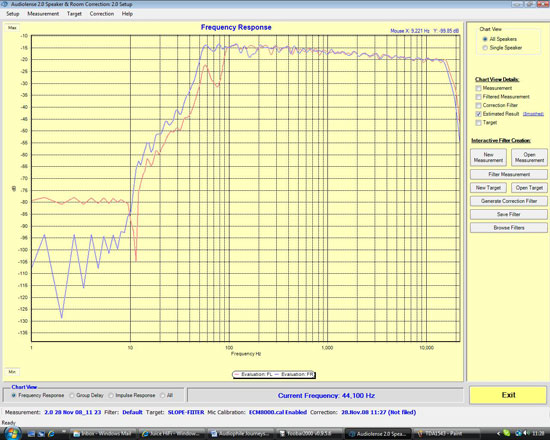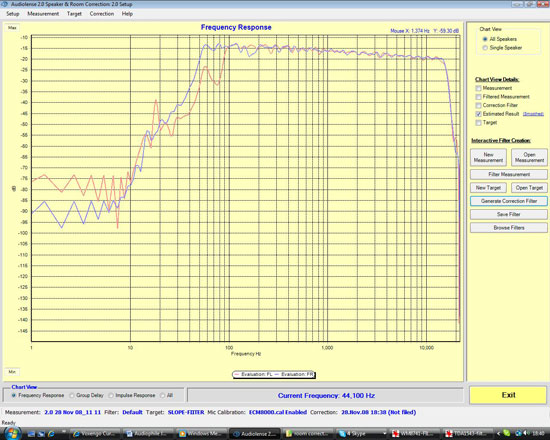Decisions, Decisions
Okay, let's apply room correction based upon the measurements taken earlier. I use a slight slope with 5dB of gain towards sub bass. I did try a flat line approach but found that the bass becomes too thin with the filter applied. Reading over the Audiolense guide, I noticed that there is a suggestion to slope things downward somewhat from low frequency to high frequency and I've found this to be my preference.
Let's have a quick look at the estimated room response for both DACs before we continue further. Unfortunately, Audiolense does not provide an option to record a frequency sweep after the correction has been applied. We've contacted Juice Hi-Fi about this and they've told us they're looking at providing this option in a future update. They did tell us that the estimated result is remarkably accurate based upon tests they've conducted themselves. If such an update is made available, we'll be sure to use the feature to present data in the future if the need arises.
Doede DAC |
Opus |
There is an unfortunate side effect at this point once the correction is applied to the TDA1543 DAC. The 20dB or so of attenuation applied by the filter means I have to turn the volume control to near maximum to get anywhere near the test volume I was using prior to applying the filters. A 6dB gain switch on the TVC does give me headroom of a couple of clicks, but it's far from optimal. To use this DAC with DRC, you'll either need to stack a number of TDA1543s in parallel or use some kind of gain stage on its output. Still, there's just about enough volume on tap for me to get an idea of its sonic signature in comparison to the earlier sound and in comparison to the WM8741.
With DRC engaged, instruments become far easier to pick out and subtle details are more noticeable at the listening position. The best word to describe the effects of DRC is balance. The other shocker is that the basic nature of both DACs remains the same. The TDA1543 midrange gains more edge definition especially on vocals (not that it needed them). The Opus soundstage gains pinpoint precision with lots of air. Complex passages of music are rendered without any perceivable congestion on both DACs.










114 Comments
View All Comments
ccd - Monday, December 1, 2008 - link
In an attempt to keep the article from getting too long, the author has skipped for a number of controversies where audiophiles have basically agreed to disagree.1) Tube vs Solid State Electronics: Go to a site like audioasylum and you can hear this debate rage ad nauseum. This is a subset of the whole analogue versus digital debate. There are "golden ears" who will swear that only SET provide the best musical reproduction and others who will claim that tubes lend a warmth to some music that is pleasing, but not accurate.
2) Full Range vs. Speakers with Crossovers: Some argue that crossovers distort the sound and others who say you can't hear it.
3) Tweaking: There are those of us who think that tweakers just like to tweak and that most of the tweaks really are not audible.
If you want Exhibit "A" for the solid state position, you need look no further than the Linkwitz Orion speaker which is a 3-way speaker for which some relatively inexpensive SS electronics is recommended. This speaker is hands down the best speaker I have personally ever heard. It also represents a trend in speakers with crossovers toward having dipole mid-ranges.
A much more appropriate article, IMHO, would have been to discuss the viability of the PC as a single box solution for sound. In the past, there have been a number of obstacles to this. First, the soundcards reputed to have the best sound reproduction (ie, Lynx) are both expensive and not designed for use by audiophiles. For example, volume control with high end sound cards is cumbersome. Second, anything beyond 2-channel sound with a Lynx card becomes extremely expensive. Third, the use of a PC as a single solution is limiting because a PC is not setup to switch between sound sources: you are limited to your CD drive and the music on your hard drive. Fourth, even the best cards lack the ability to handle certain music formats.
Some of this may be about to change with the introduction of the HDAV soundcard which was mentioned in a previous Anandtech article. An article on that soundcard and how it affects the ability of the PC to act as a soundsource without an external CD player would have been a much more interesting and appropriate article for Anandtech.
quanta - Friday, December 5, 2008 - link
To throw into the tube vs solid state amplifier argument, there seems to be two words that will throw vacuum tube into the... vacuum: Pritchard Amps. It has built quite a reputation on making warm sounds with transistors.That aside, didn't AOpen tried building a series of vacuum tube PC motherboards (eg: AK79G, AX4B-533)? Judging on how quickly it went out of production, it seems there aren't enough audiophiles to even care about the differences to sustain the market anymore, especially with the growing generation who has destroyed their eardrums with loud MP3 players...
slashbinslashbash - Monday, December 1, 2008 - link
This has got to the most ridiculous article I've ever seen on AnandTech. Far worse than the digital camera reviews -- at least there's inherent objectivity in the images produced. This whole review is just a bunch of meandering, billowy BS. Has the reviewer conducted ANY double-blind tests of these various audio components? I quote one small part of the article:"I find the battery input to provide cleaner, tighter bass notes, more perceived air throughout the mid-band and high frequency range, and better stereo imaging."
This is either a case of the placebo effect, or the battery causes the components to output slightly higher signal levels than the DC power supply. "Cleaner, tighter bass; more air in the mids and highs; and better stereo imaging" is a classic symptom of "one system is 1 dB or so louder than the other." Slight increases in loudness are not perceived as such, but rather as improvements in clarity and imaging. Pull out your SPL meter and watch the peaks on some program source with the different power sources. This is the first step in setting up a robust listening test. Matching levels is critical.
A friend and I once held a critical listening comparison of 2 CD's: one the original, one "24-bit remastered". At the first listening test, we were able to tell which disc was playing with surprising reliability. Investigating further, we were surprised to find that the remastered disc had wildly varying SPL levels from the original; it even varied from song to song. Once we matched the levels, we were unable to perceive any difference between the 2 CD's, based on single-blind tests (tester knew which was which, listener did not, tester was behind a partition wall the whole time and was never in view of the listener).
phusg - Tuesday, December 2, 2008 - link
Very good point!mindless1 - Monday, December 1, 2008 - link
Both the battery pack and wall wart were before a reasonably good (though even with a lowly LM7809 that'd be enough to negate the factor you mentioned) regulation stage that presumably remained a constant, it is not likely the end result would be higher SPL levels with one than the other. You had a significantly different situation when you and your friend started out with two different versions of the same recording.However, whether it was a placebo effect or not we can't say since we weren't there to hear it.
slashbinslashbash - Monday, December 1, 2008 - link
First, let's give the author the benefit of the doubt and say that he did indeed hear the differences he described. (Removing the placebo effect explanation, for now.)Now, you seem to be positing that the SPL *wasn't* affected by the power supply, because the power supply was sufficiently regulated; but the bass somehow magically became tighter and the mids and highs became more airy.... due to the power supply. You are saying that the power supply still caused a difference, but that the difference was more subtle and mysterious. I posited a simple explanation; yours is more complicated. Of course, either explanation is possible, but we have no way of knowing, due to the complete lack of scientific rigor in the author's discussion.
I agree, of course, that the situation is completely different from the listening test that my friend and I performed. I used it only as an example, however, of the well known acoustic phenomenon that "subtly louder sounds better" (not to mention an example of how to perform a reasonably robust audio test).
So, in effect, I was throwing down the gauntlet to the author: perform a listening test with the two different power sources. First, test the SPL output with both setups and make sure that they are identical. If they are, then have a friend switch between one and the other, giving no indicationwhich is currently hooked up. Do this 10 times; if you can identify the correct power source 8 times or more, I will believe that you can hear the difference. Write them down on paper and do not show your answers to your friend until the test is completed, and do not communicate in any way with your friend during the entire test (ideally, have both him and the equipment hidden behind a partition; and the test sequence should be created by a randomizer).
RagingDragon - Saturday, December 6, 2008 - link
The reasoning behind "battery sounds better than wall wart" is that the wall wart is a switching power supply, as such it imparts some degree of noise and ripple in the power; whereas, the battery would provide more uniform power; therefore, the battery should provide clearer more uniform sound. I haven't tested this hypothesis, nor do I care enough to do so, so I'll refrain from commenting on its correctness.Spivonious - Monday, December 1, 2008 - link
That reminds me of the time I took my original Peace Sells vinyl, original Peace Sells CD, and the 24-bit remastered Peace Sells CD, and played them all on my dad's $10k+ tube system (complete with 24-bit DAC of course).Which sounded the best? The vinyl. Isn't it silly how after all of this digital technology that we still can't imitate an analog source?
CSMR - Monday, December 1, 2008 - link
You can imitate an analog source. The people who mastered the CDs didn't want to. If you ran the vinyl into your dad's player and recorded it on PC and made a CD you would get something audibly the same as the vinyl (assuming the sound card and CD player are any good).But what about taking a digital recording and making it sound like a record? Anyone know of any good vinylify DSPs?
murray13 - Monday, December 1, 2008 - link
No one can doubt your enthusiasm Rajinder! I enjoyed reading about what you found out.Have you tried using the DRC on a 'good' PC audio card? Now that is something I would like to hear.
As I personally use headphones, using DRC is problematic at best...
The one thing that has ALWAYS bugged me about Audiophiles in general is that they use recordings that they were not there to hear when recorded. If you don't know what something is supposed to sound like, how in the world can someone say that one thing or another sounds more 'realistic' than something else, when talking about the n'th degree. {rant mode off}
With all this said, I look forward to reading the next installment.